
(a)
Interpretation:
The structure to correspond with the given common and systematic names is to be drawn.
Concept introduction:
Structural formulas are used to describe the arrangement of atoms, groups or substituents in a molecule, whereas molecular formula describes the total number and type of atoms present in a molecule. The chemical structures are described by IUPAC name or common names. IUPAC names are totally different from common names because common names do not follow any rule, whereas IUPAC names follow specific rules. The common name does not include any suffix, prefix, and numbers.
(a)
Answer to Problem 21.42SP
The structure to correspond with the given common and systematic names is given below.
Explanation of Solution
The given compound is phenyl formate.
The molecular formula of phenyl formate is
The structure of phenyl formate is given as,
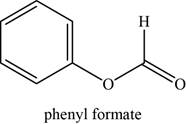
Figure 1
(b)
Interpretation:
The structure to correspond with the given common and systematic names is to be drawn.
Concept introduction:
Structural formulas are used to describe the arrangement of atoms, groups or substituents in a molecule, whereas molecular formula describes the total number and type of atoms present in a molecule. The chemical structures are described by IUPAC name or common names. IUPAC names are totally different from common names because common names do not follow any rule, whereas IUPAC names follow specific rules. The common name does not include any suffix, prefix, and numbers.
(b)
Answer to Problem 21.42SP
The structure to correspond with the given common and systematic names is given below.
Explanation of Solution
The given compound is cyclohexyl benzoate.
The molecular formula of cyclohexyl benzoate is
The structure of cyclohexyl benzoate is given as,
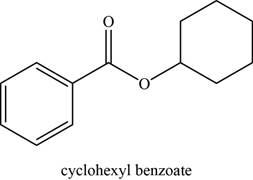
Figure 2
(c)
Interpretation:
The structure to correspond with the given common and systematic names is to be drawn.
Concept introduction:
Structural formulas are used to describe the arrangement of atoms, groups or substituents in a molecule, whereas molecular formula describes the total number and type of atoms present in a molecule. The chemical structures are described by IUPAC name or common names. IUPAC names are totally different from common names because common names do not follow any rule, whereas IUPAC names follow specific rules. The common name does not include any suffix, prefix, and numbers.
(c)
Answer to Problem 21.42SP
The structure to correspond with the given common and systematic names is given below.
Explanation of Solution
The given compound is cyclopentyl phenylacetate.
The molecular formula of cyclopentyl phenylacetate is
The structure of cyclopentyl phenylacetate is given as,
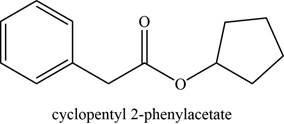
Figure 3
(d)
Interpretation:
The structure to correspond with the given common and systematic names is to be drawn.
Concept introduction:
Structural formulas are used to describe the arrangement of atoms, groups or substituents in a molecule, whereas molecular formula describes the total number and type of atoms present in a molecule. The chemical structures are described by IUPAC name or common names. IUPAC names are totally different from common names because common names do not follow any rule, whereas IUPAC names follow specific rules. The common name does not include any suffix, prefix, and numbers.
(d)
Answer to Problem 21.42SP
The structure to correspond with the given common and systematic names is given below.
Explanation of Solution
The given compound is N-butylacetamide.
The molecular formula of N-butylacetamide is
The structure of N-butylacetamide is given as,
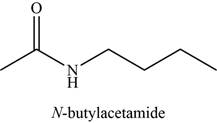
Figure 4
(e)
Interpretation:
The structure to correspond with the given common and systematic names is to be drawn.
Concept introduction:
Structural formulas are used to describe the arrangement of atoms, groups or substituents in a molecule, whereas molecular formula describes the total number and type of atoms present in a molecule. The chemical structures are described by IUPAC name or common names. IUPAC names are totally different from common names because common names do not follow any rule, whereas IUPAC names follow specific rules. The common name does not include any suffix, prefix, and numbers.
(e)
Answer to Problem 21.42SP
The structure to correspond with the given common and systematic names is given below.
Explanation of Solution
The given compound is N,N-dimethylformamide.
The molecular formula of N,N-dimethylformamide is
The structure of N,N-dimethylformamide is given as,

Figure 5
(f)
Interpretation:
The structure to correspond with the given common and systematic names is to be drawn.
Concept introduction:
Structural formulas are used to describe the arrangement of atoms, groups or substituents in a molecule, whereas molecular formula describes the total number and type of atoms present in a molecule. The chemical structures are described by IUPAC name or common names. IUPAC names are totally different from common names because common names do not follow any rule, whereas IUPAC names follow specific rules. The common name does not include any suffix, prefix, and numbers.
(f)
Answer to Problem 21.42SP
The structure to correspond with the given common and systematic names is given below.
Explanation of Solution
The given compound is benzoic propionic anhydride.
The molecular formula of benzoic propionic anhydride is
The structure of benzoic propionic anhydride is given as,
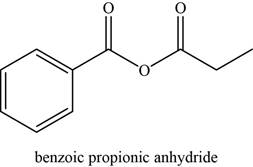
Figure 6
(g)
Interpretation:
The structure to correspond with the given common and systematic names is to be drawn.
Concept introduction:
Structural formulas are used to describe the arrangement of atoms, groups or substituents in a molecule, whereas molecular formula describes the total number and type of atoms present in a molecule. The chemical structures are described by IUPAC name or common names. IUPAC names are totally different from common names because common names do not follow any rule, whereas IUPAC names follow specific rules. The common name does not include any suffix, prefix, and numbers.
(g)
Answer to Problem 21.42SP
The structure to correspond with the given common and systematic names is given below.
Explanation of Solution
The given compound is benzamide.
The molecular formula of benzamide is
The structure of benzamide is given as,
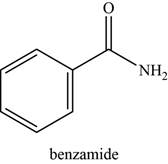
Figure 7
(h)
Interpretation:
The structure to correspond with the given common and systematic names is to be drawn.
Concept introduction:
Structural formulas are used to describe the arrangement of atoms, groups or substituents in a molecule, whereas molecular formula describes the total number and type of atoms present in a molecule. The chemical structures are described by IUPAC name or common names. IUPAC names are totally different from common names because common names do not follow any rule, whereas IUPAC names follow specific rules. The common name does not include any suffix, prefix, and numbers.
(h)
Answer to Problem 21.42SP
The structure to correspond with the given common and systematic names is given below.
Explanation of Solution
The given compound is
The molecular formula of
The structure of
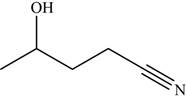
Figure 8
(i)
Interpretation:
The structure to correspond with the given common and systematic names is to be drawn.
Concept introduction:
Structural formulas are used to describe the arrangement of atoms, groups or substituents in a molecule, whereas molecular formula describes the total number and type of atoms present in a molecule. The chemical structures are described by IUPAC name or common names. IUPAC names are totally different from common names because common names do not follow any rule, whereas IUPAC names follow specific rules. The common name does not include any suffix, prefix, and numbers.
(i)
Answer to Problem 21.42SP
The structure to correspond with the given common and systematic names is given below.
Explanation of Solution
The given compound is
The molecular formula of
The structure of
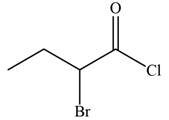
Figure 9
(j)
Interpretation:
The structure to correspond with the given common and systematic names is to be drawn.
Concept introduction:
Structural formulas are used to describe the arrangement of atoms, groups or substituents in a molecule, whereas molecular formula describes the total number and type of atoms present in a molecule. The chemical structures are described by IUPAC name or common names. IUPAC names are totally different from common names because common names do not follow any rule, whereas IUPAC names follow specific rules. The common name does not include any suffix, prefix, and numbers.
(j)
Answer to Problem 21.42SP
The structure to correspond with the given common and systematic names is given below.
Explanation of Solution
The given compound is
The molecular formula of
The structure of
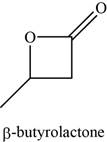
Figure 10
(k)
Interpretation:
The structure to correspond with the given common and systematic names is to be drawn.
Concept introduction:
Structural formulas are used to describe the arrangement of atoms, groups or substituents in a molecule, whereas molecular formula describes the total number and type of atoms present in a molecule. The chemical structures are described by IUPAC name or common names. IUPAC names are totally different from common names because common names do not follow any rule, whereas IUPAC names follow specific rules. The common name does not include any suffix, prefix, and numbers.
(k)
Answer to Problem 21.42SP
The structure to correspond with the given common and systematic names is given below.
Explanation of Solution
The given compound is phenyl isocyanate.
The molecular formula of phenyl isocyanate is
The structure of phenyl isocyanate is given as,
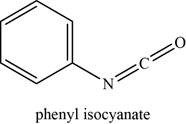
Figure 11
(l)
Interpretation:
The structure to correspond with the given common and systematic names is to be drawn.
Concept introduction:
Structural formulas are used to describe the arrangement of atoms, groups or substituents in a molecule, whereas molecular formula describes the total number and type of atoms present in a molecule. The chemical structures are described by IUPAC name or common names. IUPAC names are totally different from common names because common names do not follow any rule, whereas IUPAC names follow specific rules. The common name does not include any suffix, prefix, and numbers.
(l)
Answer to Problem 21.42SP
The structure to correspond with the given common and systematic names is given below.
Explanation of Solution
The given compound is cyclobutyl ethyl carbonate.
The molecular formula of cyclobutyl ethyl carbonate is
The structure of cyclobutyl ethyl carbonate is given as,
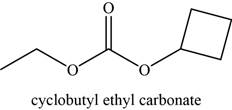
Figure 12
(m)
Interpretation:
The structure to correspond with the given common and systematic names is to be drawn.
Concept introduction:
Structural formulas are used to describe the arrangement of atoms, groups or substituents in a molecule, whereas molecular formula describes the total number and type of atoms present in a molecule. The chemical structures are described by IUPAC name or common names. IUPAC names are totally different from common names because common names do not follow any rule, whereas IUPAC names follow specific rules. The common name does not include any suffix, prefix, and numbers.
(m)
Answer to Problem 21.42SP
The structure to correspond with the given common and systematic names is given below.
Explanation of Solution
The given compound is
The molecular formula of
The structure of
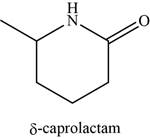
Figure 13
(n)
Interpretation:
The structure to correspond with the given common and systematic names is to be drawn.
Concept introduction:
Structural formulas are used to describe the arrangement of atoms, groups or substituents in a molecule, whereas molecular formula describes the total number and type of atoms present in a molecule. The chemical structures are described by IUPAC name or common names. IUPAC names are totally different from common names because common names do not follow any rule, whereas IUPAC names follow specific rules. The common name does not include any suffix, prefix, and numbers.
(n)
Answer to Problem 21.42SP
The structure to correspond with the given common and systematic names is given below.
Explanation of Solution
The given compound is trichloroacetic anhydride.
The molecular formula of trichloroacetic anhydride is
The structure of trichloroacetic anhydride is given as,
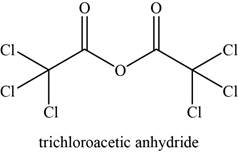
Figure 14
(o)
Interpretation:
The structure to correspond with the given common and systematic names is to be drawn.
Concept introduction:
Structural formulas are used to describe the arrangement of atoms, groups or substituents in a molecule, whereas molecular formula describes the total number and type of atoms present in a molecule. The chemical structures are described by IUPAC name or common names. IUPAC names are totally different from common names because common names do not follow any rule, whereas IUPAC names follow specific rules. The common name does not include any suffix, prefix, and numbers.
(o)
Answer to Problem 21.42SP
The structure to correspond with the given common and systematic names is given below.
Explanation of Solution
The given compound is Ethyl-N-methyl carbamate.
The molecular formula of Ethyl-N-methyl carbamate is
The structure of Ethyl-N-methyl carbamate is given as,
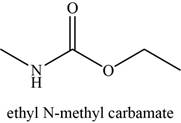
Figure 15
Want to see more full solutions like this?
Chapter 21 Solutions
Organic Chemistry Plus Masteringchemistry With Pearson Etext, Global Edition
- Under aqueous basic conditions, nitriles will react to form a neutral organic intermediate 1 that has an N atom in it first, and then they will continue to react to form the final product 2: NC H₂O он- H₂O 1 2 OH Draw the missing intermediate 1 and the final product 2 in the box below. You can draw the two structures in any arrangement you like. Click and drag to start drawing a structure.arrow_forwardAssign these COSY Spectrumarrow_forwardAssign these C-NMR and H-NMR Spectrumarrow_forward
- Predict the product of this organic reaction: IZ + HO i P+H₂O Specifically, in the drawing area below draw the skeletal ("line") structure of P. If there is no reasonable possibility for P, check the No answer box under the drawing area. No Answer Click and drag to start drawing a structure. ☐ :arrow_forwardPredict the products of this organic reaction: 0 O ----- A + KOH ? CH3-CH2-C-O-CH2-C-CH3 Specifically, in the drawing area below draw the condensed structure of the product, or products, of this reaction. (If there's more than one product, draw them in any arrangement you like, so long as they aren't touching.) If there aren't any products because this reaction won't happen, check the No reaction box under the drawing area. No reaction Click anywhere to draw the first atom of your structure. X ⑤ èarrow_forwardPredict the products of this organic reaction: O CH3 + H2O + HCI A A? CH3-CH2-C-N-CH3 Specifically, in the drawing area below draw the condensed structure of the product, or products, of this reaction. If there's more than one product, draw them in any arrangement you like, so long as they aren't touching. If there aren't any products because this reaction won't happen, check the No reaction box under the drawing area. No Reaction Click anywhere to draw the first atom of your structure.arrow_forward
- What is the missing reactant in this organic reaction? R+ HO-C-CH2-CH3 0= CH3 CH3 —CH, C−NH—CH CH3 + H₂O Specifically, in the drawing area below draw the condensed structure of R. If there is more than one reasonable answer, you can draw any one of them. If there is no reasonable answer, check the No answer box under the drawing area. Note for advanced students: you may assume no products other than those shown above are formed. No Answer Click anywhere to draw the first atom of your structure. €arrow_forward个 CHEM&131 9267 - $25 - Intro to Mail - Hutchison, Allison (Student x Aktiv Learnin https://app.aktiv.com Draw the product of the reaction shown below. Ignore inorganic byproducts. + Na2Cr2O7 Acetone, H2SO4 Type here to search Dryng OH W Prarrow_forwardPredict the products of this organic reaction: OH + NaOH A? Specifically, in the drawing area below draw the skeletal ("line") structure of the product, or products, of this reaction. (If there's more than one product, draw them in any arrangement you like, so long as they aren't touching.) If there aren't any products because this reaction won't happen, check the No reaction box under the drawing area. No reaction Click and drag to start drawing a structure. ✓ Sarrow_forward
- Predict the products of this organic reaction: CH3-C-O-CH2-CH2-C-CH3 + H₂O ? A Specifically, in the drawing area below draw the condensed structure of the product, or products, of this reaction. (If there's more than one product, draw them in any arrangement you like, so long as they aren't touching.) If there aren't any products because this reaction won't happen, check the No reaction box under the drawing area. No reaction Click anywhere to draw the first atom of your structure. :☐ darrow_forwardDE d. Draw an arrow pushing mechanism for the following IN O CI N fo 人 P Polle DELL prt sc home end ins F5 F6 F7 F8 F9 F10 F11 F12arrow_forwardPredict the products of this organic reaction: + H₂O H* ? A Specifically, in the drawing area below draw the skeletal ("line") structure of the product, or products, of this reaction. (If there's more than one product, draw them in any arrangement you like, so long as they aren't touching.) If there aren't any products because this reaction won't happen, check the No reaction box under the drawing area. No Reaction Click and drag to start drawing a structure.arrow_forward
 Chemistry for Today: General, Organic, and Bioche...ChemistryISBN:9781305960060Author:Spencer L. Seager, Michael R. Slabaugh, Maren S. HansenPublisher:Cengage Learning
Chemistry for Today: General, Organic, and Bioche...ChemistryISBN:9781305960060Author:Spencer L. Seager, Michael R. Slabaugh, Maren S. HansenPublisher:Cengage Learning Organic Chemistry: A Guided InquiryChemistryISBN:9780618974122Author:Andrei StraumanisPublisher:Cengage Learning
Organic Chemistry: A Guided InquiryChemistryISBN:9780618974122Author:Andrei StraumanisPublisher:Cengage Learning

